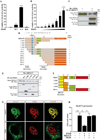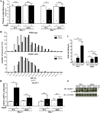Angiotensin II Induces Skeletal Muscle Atrophy by Activating TFEB-Mediated MuRF1 Expression
- PMID: 26137861
- PMCID: PMC4537692
- DOI: 10.1161/CIRCRESAHA.114.305393
Angiotensin II Induces Skeletal Muscle Atrophy by Activating TFEB-Mediated MuRF1 Expression
Abstract
Rationale: Skeletal muscle wasting with accompanying cachexia is a life threatening complication in congestive heart failure. The molecular mechanisms are imperfectly understood, although an activated renin-angiotensin aldosterone system has been implicated. Angiotensin (Ang) II induces skeletal muscle atrophy in part by increased muscle-enriched E3 ubiquitin ligase muscle RING-finger-1 (MuRF1) expression, which may involve protein kinase D1 (PKD1).
Objective: To elucidate the molecular mechanism of Ang II-induced skeletal muscle wasting.
Methods and results: A cDNA expression screen identified the lysosomal hydrolase-coordinating transcription factor EB (TFEB) as novel regulator of the human MuRF1 promoter. TFEB played a key role in regulating Ang II-induced skeletal muscle atrophy by transcriptional control of MuRF1 via conserved E-box elements. Inhibiting TFEB with small interfering RNA prevented Ang II-induced MuRF1 expression and atrophy. The histone deacetylase-5 (HDAC5), which was directly bound to and colocalized with TFEB, inhibited TFEB-induced MuRF1 expression. The inhibition of TFEB by HDAC5 was reversed by PKD1, which was associated with HDAC5 and mediated its nuclear export. Mice lacking PKD1 in skeletal myocytes were resistant to Ang II-induced muscle wasting.
Conclusion: We propose that elevated Ang II serum concentrations, as occur in patients with congestive heart failure, could activate the PKD1/HDAC5/TFEB/MuRF1 pathway to induce skeletal muscle wasting.
Keywords: angiotensin II; gene expression regulation; heart failure; histone deacetylase 5; muscle RING-finger-1; protein kinase D; transcription factor EB.
© 2015 American Heart Association, Inc.
Conflict of interest statement
The authors are not aware of interest conflicts.
Figures








References
-
- Ciciliot S, Rossi AC, Dyar KA, Blaauw B, Schiaffino S. Muscle type and fiber type specificity in muscle wasting. Int J Biochem Cell Biol. 2013;45:2191–2199. - PubMed
-
- Borina E, Pellegrino MA, D'Antona G, Bottinelli R. Myosin and actin content of human skeletal muscle fibers following 35 days bed rest. Scandinavian journal of medicine & science in sports. 2010;20:65–73. - PubMed
-
- Snow LM, Sanchez OA, McLoon LK, Serfass RC, Thompson LV. Effect of endurance exercise on myosin heavy chain isoform expression in diabetic rats with peripheral neuropathy. American journal of physical medicine & rehabilitation / Association of Academic Physiatrists. 2005;84:770–779. - PubMed
-
- Ciechanover A. The ubiquitin proteolytic system: From a vague idea, through basic mechanisms, and onto human diseases and drug targeting. Neurology. 2006;66:S7–S19. - PubMed
Publication types
MeSH terms
Substances
Grants and funding
LinkOut - more resources
Full Text Sources
Other Literature Sources
Miscellaneous

